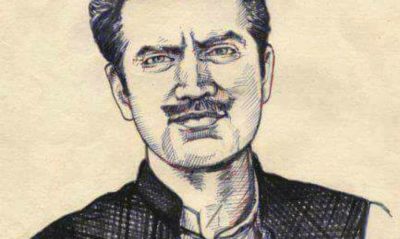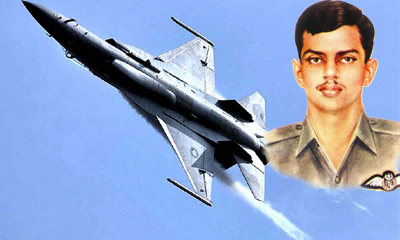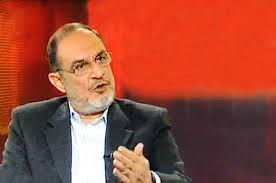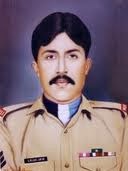Category Pakistan
راشد منہاس نے دشمن کی سازش کیسے ناکام بنائی
راشد منہاس 17 فروری 1951 کو کراچی میں پیدا ہوئے اور وہ نشان حیدر کا
اعزاز حاصل کرنے والے سب سے کم عمر اور پاک فضائیہ کے پہلے آفیسر ہیں۔ راشد منہاس نے اپنی ابتدائی تعلیم کراچی میں حاصل کی اور سترہ سال کی عمر میں پاک فضائیہ کی رسالپور اکیڈمی میں بطور فلائنگ کیڈٹ داخلہ لیا۔ 1971 میں راشد مہناس نے اکیڈمی سے جنرل ڈیوٹی پائلٹ کی حیثیت سے گریجویٹ کیا اور انہیں کراچی میں پی اے ایف بیس مسرور پر پوسٹ کیا گیا تاکہ لڑاکا پائلٹ کی تربیت حاصل کرسکیں۔
20اگست 1971 کو زیرتربیت پائلٹ کی حیثیت سے راشد منہاس ٹی 33 جیٹ ٹرینر کو اڑانے والے تھے جب بنگالی پائلٹ انسٹرکٹر فلائٹ لیفٹیننٹ مطیع الرحمان بھی ان کے ساتھ سوار ہوا۔ دوران پرواز مطیع الرحمان نے راشد منہاس کو سر پرضرب لگا کر بے ہوش کیا اور پرواز کا کنٹرول سنبھال کر طیارے کا رخ ہندوستان کی جانب موڑ دیا۔ اس وقت جب ہندوستان کا فاصلہ 40 میل رہ گیا تھا، راشد منہاس کو ہوش آیا اور انہوں نے طیارے کا کنٹرول دوبارہ حاصل کرنے کی کوشش کی، اس میں ناکامی کے بعد نوجوان پائلٹ کے پاس اپنے طیارے کو ہندوستان لے جانے سے روکنے کا ایک ہی راستہ رہ گیا تھا اور انہوں نے ہندوستانی سرحد سے محض 32 دور طیارے کو گرا کر اپنی جان پاکستان کے لیے قربان کردی۔
راشد منہاس کو 21 اگست 1971 کو مکمل فوجی اعزاز کے ساتھ سپرد خاک کیا گیا اور ان نوجوان پائلٹ کے پورے خاندان سمیت پاک فضائیہ اور دیگر مسلح افواج کے عہدیداران اس موقع پر موجود تھے۔ راشد منہاس کو بعد از وفات پاکستان کا سب سے اعلیٰ فوجی اعزاز نشان حیدر دینے کا اعلان اس وقت کے صدر جنرل یحییٰ خان نے کیا اور اس طرح وہ اس اعزاز کو پانے والے سے سب سے کم عمر اور پاک فضائیہ کے اب تک واحد رکن بن گئے۔ اپنے بیٹے کی شہادت پر راشد منہاس کے والد عبدالماجد منہاس نے یہ کہا ” اگرچہ بیٹے کی وفات کا دکھ کبھی ختم نہ ہونے والا ہے مگر مجھے اس بات پر فخر ہے کہ اس نے ایک نیک مقصد اور ملک و قوم کے وقار کے لیے اپنی جان قربان کی”۔ اٹھائیس اگست 1971 کو دیئے جانے والے ایک انٹرویو میں عبدالماجد منہاس نے کہا کہ ان کا بیٹا شروع سے ہی ایسے کرئیر میں دلچسپی رکھتا تھا جس کے ذریعے وہ ملک و قوم کی خدمت اپنی بہترین صلاحیتوں کے ساتھ کرسکے۔ ان کا کہنا تھا کہ راشد منہاس زمانہ طالبعلمی میں جنگوں پر لکھی جانے والی کتابوں کو پڑھنا پسند کرتے تھے اور ان کے اہم اقوال اپنی ڈائری پر نقل کرلیتے تھے۔
راشد منہاس کی ڈائری پر درج اقوال میں سے ایک میں کہا گیا تھا ” ایک شخص کے لیے سب سے بڑا اعزاز اپنے ملک کے لیے قربان کردینا اور قوم کی امیدوں پر پورا اترنا ہے”۔ راشد منہاس کی تعلیم کے حوالے سے سوال کے جواب میں انہوں نے کہا کہ ان کے بیٹے نے راولپنڈی کے میری کیمبرج اسکول میں ابتدائی تعلیم حاصل کی اور سنیئر کیمبرج کراچی سے کیا۔ راشد منہاس نے پاک فضائیہ 1968 میں پاک فضائیہ کا حصہ بنے اور پی اے ایف اکیڈمی سے سائنس کے مضمون میں گریجویشن ڈگری اعزاز کے ساتھ حاصل کی۔ عبدالماجد منہاس نے کہا کہ ان کی بڑا بیٹا ٹیکنیکل مزاج رکھتا تھا اوربارہ سال کی عمر میں ڈرائیونگ سیکھ چکا تھا۔ اس کی زاتی لائبریری میں دیگر موضوعات کے ساتھ ساتھ الیکٹرونکس اور علم فلکیات کی کتابیں بھی شامل تھیں۔ اس کے مشاغل میں پڑھنا، فوٹوگرافی، ہاکی اور بلیئرڈ شامل تھے۔ انہوں نے مزید بتایا کہ راشد منہاس ابتدائی عمر سے مزاجاً ایک آئیڈیلسٹ تھے جو اپنے ملک کی خدمت کرنا چاہتا تھا۔
ان کا کہنا تھا کہ راشد منہاس اپنے بہنوئی میجر ناصر احمد خان سے بہت زیادہ متاثر تھے جنھیں ستارہ جرات سے نوازا گیا تھا ” میرا بیٹا ہر کام کو مکمل کرنے والا، متعدل مزاج لڑکا تھا اور اسے پیسہ کمانے سے دلچسپی نہیں تھی”۔ عبد الماجد منہاس نے کہا کہ راشد منہاس اپنی پیدائش سے ہی پاک فضائیہ سے جڑا ہوا تھا کیونکہ اس کی پیدائش کراچی کے ڈرگ روڈ پر واقع پی اے ایف ہسپتال میں ہوئی ” میرے بیٹے نے اتنی بڑی قربانی دے کر میرا سر فخر سے بلند کردیا ہے”۔
انہوں نے مزید کہا ” ہمارے پاس ایسے فوجی ہیں جو اپنی زندگیاں قوم پر نچھاور کرنے کے لیے تیار ہیں”۔
راشد منہاس 17 فروری 1951 کو کراچی میں پیدا ہوئے اور وہ نشان حیدر کا
اعزاز حاصل کرنے والے سب سے کم عمر اور پاک فضائیہ کے پہلے آفیسر ہیں۔ راشد منہاس نے اپنی ابتدائی تعلیم کراچی میں حاصل کی اور سترہ سال کی عمر میں پاک فضائیہ کی رسالپور اکیڈمی میں بطور فلائنگ کیڈٹ داخلہ لیا۔ 1971 میں راشد مہناس نے اکیڈمی سے جنرل ڈیوٹی پائلٹ کی حیثیت سے گریجویٹ کیا اور انہیں کراچی میں پی اے ایف بیس مسرور پر پوسٹ کیا گیا تاکہ لڑاکا پائلٹ کی تربیت حاصل کرسکیں۔
راشد منہاس کو 21 اگست 1971 کو مکمل فوجی اعزاز کے ساتھ سپرد خاک کیا گیا اور ان نوجوان پائلٹ کے پورے خاندان سمیت پاک فضائیہ اور دیگر مسلح افواج کے عہدیداران اس موقع پر موجود تھے۔ راشد منہاس کو بعد از وفات پاکستان کا سب سے اعلیٰ فوجی اعزاز نشان حیدر دینے کا اعلان اس وقت کے صدر جنرل یحییٰ خان نے کیا اور اس طرح وہ اس اعزاز کو پانے والے سے سب سے کم عمر اور پاک فضائیہ کے اب تک واحد رکن بن گئے۔ اپنے بیٹے کی شہادت پر راشد منہاس کے والد عبدالماجد منہاس نے یہ کہا ” اگرچہ بیٹے کی وفات کا دکھ کبھی ختم نہ ہونے والا ہے مگر مجھے اس بات پر فخر ہے کہ اس نے ایک نیک مقصد اور ملک و قوم کے وقار کے لیے اپنی جان قربان کی”۔ اٹھائیس اگست 1971 کو دیئے جانے والے ایک انٹرویو میں عبدالماجد منہاس نے کہا کہ ان کا بیٹا شروع سے ہی ایسے کرئیر میں دلچسپی رکھتا تھا جس کے ذریعے وہ ملک و قوم کی خدمت اپنی بہترین صلاحیتوں کے ساتھ کرسکے۔ ان کا کہنا تھا کہ راشد منہاس زمانہ طالبعلمی میں جنگوں پر لکھی جانے والی کتابوں کو پڑھنا پسند کرتے تھے اور ان کے اہم اقوال اپنی ڈائری پر نقل کرلیتے تھے۔
جنرل اختر عبدارحمان ایک عہد ساز شخصیت
General Hameed Gul
Army career
Saudi influence
Career as ISI Chief
Execution of failed Jalalabad operation
Lieutenant-General Shahid Aziz
Military career
Post-retirement
General Akhtar Abdur Rahman
 Akhtar Abdur Rahman Khan b. 11 June 1924 – 17 August 1988), was an influential statesman and a four-star rank general officer who tenured as the Chairman of the Joint Chiefs of Staff Committee from 1987–1988 and as Director-General Inter-Services Intelligence (ISI) from 1979-1987.[1] As director of the ISI, Akhtar holds a world prestige for masterminding the resistance network against the Soviet Union in their war to protect the fragile regime, the Communist Afghanistan.
Akhtar Abdur Rahman Khan b. 11 June 1924 – 17 August 1988), was an influential statesman and a four-star rank general officer who tenured as the Chairman of the Joint Chiefs of Staff Committee from 1987–1988 and as Director-General Inter-Services Intelligence (ISI) from 1979-1987.[1] As director of the ISI, Akhtar holds a world prestige for masterminding the resistance network against the Soviet Union in their war to protect the fragile regime, the Communist Afghanistan.Early life and education
Military service
Director of Inter-Services Intelligence
Chairman joint chiefs
Role in the Soviet–Afghan War
Death
Books mentioning General Akhtar
-
Fateh by Haroon-ur-Rasheed
-
Silent soldier by Mohammad Yousaf
-
The Bear Trap by Mohammad Yousaf and Mark Adkin
-
Charlie Wilson’s War by George Crile
-
Ghost Wars by Steve Coll
-
A Case of Exploding Mangoes by Mohammed Hanif
Lalak Jan Shaahed
Northern Light Infantry deployment
Kargil War
Mountain combat
Final combat
Death
Sarfaraz Ahmed Rafiqui
Indo-Pakistan War of 1965
Honors and legacy

M.M. Alam – Falcon of Pakistan Air Force
Early life
Service with the Pakistan Air Force
Indo-Pakistani War of 1965
-
September 6, 1965, 1× Hawker Hunter[citation needed]
-
September 7, 1965, 5× Hawker Hunters[citation needed]
-
Squadron Leader Onkar Nath Kacker, No. 27 Sqn, POW
-
Squadron Leader A B Devayya, No. 7 Sqn also claimed by Flt Lt Amjad Hussain [12]
-
Squadron Leader Suresh B Bhagwat, No. 7 Sqn
-
Flight Lieutenant B Guha, No. 7 Sqn
-
Flying Officer Jagdev Singh Brar, No. 7 Sqn, KIA, near Sangla Hill.
-
-
September 16, 1965, 1× Hawker Hunter
-
Flying Officer Farokh Dara Bunsha, No. 7 Sqn, KIA, near Amritsar.
-
Soviet War in Afghanistan
Death
Major Tufail Mohammad
 Tufail Mohammad ( c. 1914 – 7 August 1958) was born in Hoshiarpur, Punjab. Mohammad was posthumously awarded the Nishan-e-Haider, Pakistan’s highest military award and is the only person to win the award for an action outside the Indo-Pakistan Wars. In 1958, Major Tufail Muhammed was posted to East Pakistan as the Company Commander of a battalion of East Pakistan Rifles (a Para military force for border security). During his command, Indian troops violating international borders captured a village in the area of Laskhmipur of East Pakistan. On August 7, 1958 Major Tufail launched an assault to force withdrawal of Indian troops from the village; He divided his men into three groups and attacked Indian troops during the dark hours of August 7.
Tufail Mohammad ( c. 1914 – 7 August 1958) was born in Hoshiarpur, Punjab. Mohammad was posthumously awarded the Nishan-e-Haider, Pakistan’s highest military award and is the only person to win the award for an action outside the Indo-Pakistan Wars. In 1958, Major Tufail Muhammed was posted to East Pakistan as the Company Commander of a battalion of East Pakistan Rifles (a Para military force for border security). During his command, Indian troops violating international borders captured a village in the area of Laskhmipur of East Pakistan. On August 7, 1958 Major Tufail launched an assault to force withdrawal of Indian troops from the village; He divided his men into three groups and attacked Indian troops during the dark hours of August 7. 

















